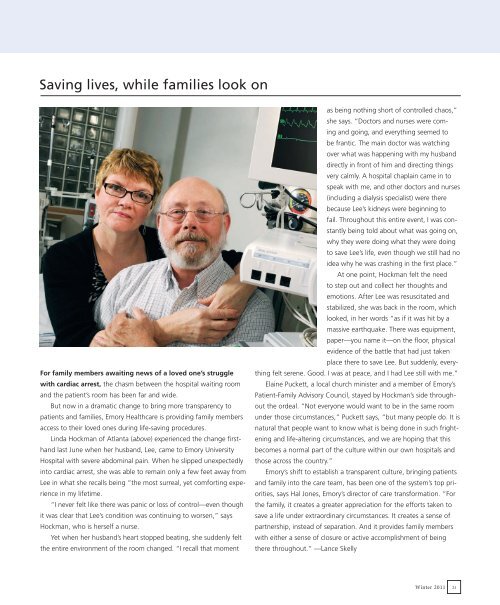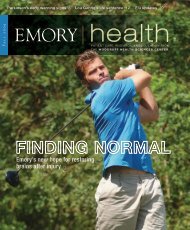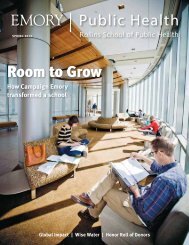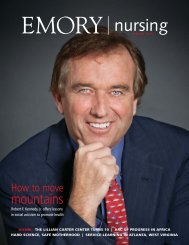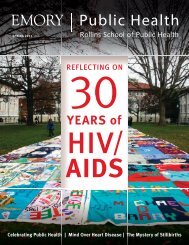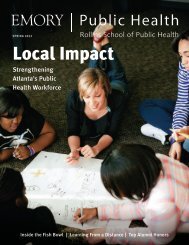returning quality to life - Woodruff Health Sciences Center - Emory ...
returning quality to life - Woodruff Health Sciences Center - Emory ...
returning quality to life - Woodruff Health Sciences Center - Emory ...
Create successful ePaper yourself
Turn your PDF publications into a flip-book with our unique Google optimized e-Paper software.
Saving lives, while families look on<br />
For family members awaiting news of a loved one’s struggle<br />
with cardiac arrest, the chasm between the hospital waiting room<br />
and the patient’s room has been far and wide.<br />
But now in a dramatic change <strong>to</strong> bring more transparency <strong>to</strong><br />
patients and families, <strong>Emory</strong> <strong>Health</strong>care is providing family members<br />
access <strong>to</strong> their loved ones during <strong>life</strong>-saving procedures.<br />
Linda Hockman of Atlanta (above) experienced the change firsthand<br />
last June when her husband, Lee, came <strong>to</strong> <strong>Emory</strong> University<br />
Hospital with severe abdominal pain. When he slipped unexpectedly<br />
in<strong>to</strong> cardiac arrest, she was able <strong>to</strong> remain only a few feet away from<br />
Lee in what she recalls being “the most surreal, yet comforting experience<br />
in my <strong>life</strong>time.<br />
“I never felt like there was panic or loss of control—even though<br />
it was clear that Lee’s condition was continuing <strong>to</strong> worsen,” says<br />
Hockman, who is herself a nurse.<br />
Yet when her husband’s heart s<strong>to</strong>pped beating, she suddenly felt<br />
the entire environment of the room changed. “I recall that moment<br />
as being nothing short of controlled chaos,”<br />
she says. “Doc<strong>to</strong>rs and nurses were coming<br />
and going, and everything seemed <strong>to</strong><br />
be frantic. The main doc<strong>to</strong>r was watching<br />
over what was happening with my husband<br />
directly in front of him and directing things<br />
very calmly. A hospital chaplain came in <strong>to</strong><br />
speak with me, and other doc<strong>to</strong>rs and nurses<br />
(including a dialysis specialist) were there<br />
because Lee’s kidneys were beginning <strong>to</strong><br />
fail. Throughout this entire event, I was constantly<br />
being <strong>to</strong>ld about what was going on,<br />
why they were doing what they were doing<br />
<strong>to</strong> save Lee’s <strong>life</strong>, even though we still had no<br />
idea why he was crashing in the first place.”<br />
At one point, Hockman felt the need<br />
<strong>to</strong> step out and collect her thoughts and<br />
emotions. After Lee was resuscitated and<br />
stabilized, she was back in the room, which<br />
looked, in her words “as if it was hit by a<br />
massive earthquake. There was equipment,<br />
paper—you name it—on the floor, physical<br />
evidence of the battle that had just taken<br />
place there <strong>to</strong> save Lee. But suddenly, everything<br />
felt serene. Good. I was at peace, and I had Lee still with me.”<br />
Elaine Puckett, a local church minister and a member of <strong>Emory</strong>’s<br />
Patient-Family Advisory Council, stayed by Hockman’s side throughout<br />
the ordeal. “Not everyone would want <strong>to</strong> be in the same room<br />
under those circumstances,” Puckett says, “but many people do. It is<br />
natural that people want <strong>to</strong> know what is being done in such frightening<br />
and <strong>life</strong>-altering circumstances, and we are hoping that this<br />
becomes a normal part of the culture within our own hospitals and<br />
those across the country.”<br />
<strong>Emory</strong>’s shift <strong>to</strong> establish a transparent culture, bringing patients<br />
and family in<strong>to</strong> the care team, has been one of the system’s <strong>to</strong>p priorities,<br />
says Hal Jones, <strong>Emory</strong>’s direc<strong>to</strong>r of care transformation. “For<br />
the family, it creates a greater appreciation for the efforts taken <strong>to</strong><br />
save a <strong>life</strong> under extraordinary circumstances. It creates a sense of<br />
partnership, instead of separation. And it provides family members<br />
with either a sense of closure or active accomplishment of being<br />
there throughout.” —Lance Skelly<br />
Winter 2011 21


